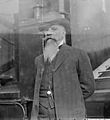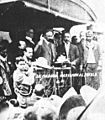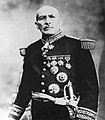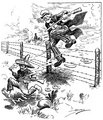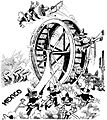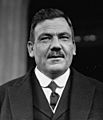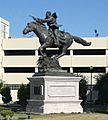Mexican Revolution facts for kids
Quick facts for kids Mexican Revolution(Revolución mexicana) |
|||||||
|---|---|---|---|---|---|---|---|
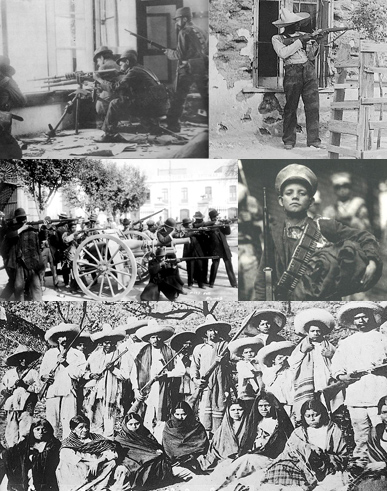 Collage of the Mexican Revolution |
|||||||
|
|||||||
| Belligerents | |||||||
|
1910–1911: Federal troops led by Porfirio Díaz |
1910–1911: Maderistas Orozquistas Magonistas Zapatistas |
||||||
| 1911–1913: Forces led by Bernardo Reyes Forces led by Félix Díaz Orozquistas Magonistas Zapatistas |
1911–1913: Maderistas |
||||||
| 1913–1914: Forces led by Victoriano Huerta |
1913–1914: Carrancistas Villistas Zapatistas |
||||||
| 1914–1919: Villistas Zapatistas Forces led by Félix Díaz Forces led by Aureliano Blanquet |
1914–1919: Seditionistas |
||||||
|
1920: |
1920: |
||||||
| Commanders and leaders | |||||||
| 1910–1911: Porfirio Díaz Ramón Corral José Yves Limantour Manuel Mondragón 1911–1913: Pascual Orozco (Fought own revolution after Díaz was overthrown and later sided with Huerta after Huerta took power.) Bernardo Reyes † (Led own revolution until his death in 1913.) Félix Díaz (sided with Reyes and later Huerta after Reyes died in 1913.) Emiliano Zapata (Sided with Orozco until Huerta took power.) Ricardo Flores Magón (POW) 1913–1914: Victoriano Huerta Aureliano Blanquet Pascual Orozco ( † in 1915) Manuel Mondragón (Until June 1913) Francisco León de la Barra Francisco S. Carvajal 1914–1919: Pancho Villa Emiliano Zapata † Félix Díaz Aureliano Blanquet † 1920: Álvaro Obregón |
1910–1911: Francisco I. Madero Pascual Orozco Bernardo Reyes Pancho Villa Emiliano Zapata Ricardo Flores Magón 1911–1913: Francisco I. Madero † José María Pino Suárez † Pancho Villa Venustiano Carranza Victoriano Huerta (Secretly sided with Reyes against Madero until Reyes died in 1913. After Reyes died, Huerta launched his own revolution.) Aureliano Blanquet (Also secretly sided with Reyes until his death.) 1913–1914: Venustiano Carranza Pancho Villa Emiliano Zapata Álvaro Obregón Plutarco Elías Calles 1914–1919: Venustiano Carranza Álvaro Obregón 1920: Venustiano Carranza † |
||||||
| Strength | |||||||
250,000 – 300,000 |
255,000 – 290,000 |
||||||
| Casualties and losses | |||||||
700,000 to 1,375,000 civilian dead (using 2 million figure) |
|||||||
The Mexican Revolution was a huge armed conflict in Mexico. It began in 1910 and lasted for about ten years. This revolution changed Mexico's government and society a lot.
Before the revolution, Mexico was ruled by Porfirio Díaz for many years. He was a strong leader, but he held all the power. Most people had no say in how the country was run. Also, a few rich people owned most of the land and wealth. This led to a lot of unfairness for ordinary people.
The revolution started as an uprising against Díaz. It then grew into a complex civil war with many different groups fighting. These groups had different ideas about how Mexico should be. Some wanted more freedom, others wanted land for farmers. The fighting mostly ended around 1920. That's when Álvaro Obregón, a key revolutionary leader, became president.
Contents
What Caused the Mexican Revolution?
The main reason for the revolution was the long rule of Porfirio Díaz. He had been president for over 30 years. People were tired of his strict rule. They wanted more freedom and a chance to choose their leaders.
The 1910 Election and Its Impact
The 1910 election was a big spark for the revolution. Francisco I. Madero challenged Díaz for president. Madero wanted fair elections and more democracy. Díaz, however, rigged the election and had Madero arrested.
After Madero was released, he called for an armed uprising. This call started the revolution in November 1910. Many people, including farmers and middle-class citizens, joined Madero's cause.
Key Leaders and Shifting Power
The Mexican Revolution had many important leaders. Their goals and alliances often changed. This made the conflict very complicated.
The Fall of Díaz and Madero's Presidency
In 1911, Díaz was forced to leave power and went into exile. Francisco I. Madero became the new president. He was elected fairly, which was a big step for Mexico.
However, Madero faced challenges from all sides. Some thought he was too weak. Others felt he wasn't making changes fast enough. In 1913, Madero and his vice president were overthrown and killed. This event is known as the Ten Tragic Days.
Huerta's Rule and the Rise of New Leaders
After Madero's death, General Victoriano Huerta took power. He was supported by those who wanted to go back to the old ways. But many revolutionary leaders opposed Huerta.
- Venustiano Carranza led the Constitutionalist faction.
- Pancho Villa led a powerful army in the north.
- Emiliano Zapata fought for land rights in the south.
These leaders joined forces to fight against Huerta. They successfully removed him from power in 1914.
Civil War Among Revolutionaries
Once Huerta was gone, the revolutionary groups began to fight each other. They disagreed on how Mexico should be governed. This led to a new phase of civil war from 1914 to 1915.
Venustiano Carranza's Constitutionalist Army became the strongest. They defeated Pancho Villa's forces. Emiliano Zapata continued his fight for land, but he was killed in 1919.
The End of the Armed Conflict
The main fighting of the revolution largely ended around 1920. Venustiano Carranza was president, but he was also killed that year. Álvaro Obregón then became president.
The Mexican Constitution of 1917
A very important outcome of the revolution was the creation of the Mexican Constitution of 1917. This new constitution set up a framework for a more fair society. It included:
- Rules for land reform, giving land back to farmers.
- Rights for workers, like an eight-hour workday.
- Limits on the power of the Catholic Church.
Many historians see this constitution as the official end of the armed conflict. It laid the groundwork for modern Mexico.
Impact and Legacy
The Mexican Revolution was one of the most important events in Mexico's history. It caused a lot of changes and had a lasting impact.
- About 1.5 million people died during the conflict.
- Many Mexicans moved to other countries, especially the United States.
- The old Federal Army was dissolved.
- The revolution led to a new government focused on "social justice."
The revolution shaped Mexico for decades. It brought about major reforms in land ownership, labor rights, and education. The Monument to the Revolution in Mexico City stands as a symbol of this important time.
Images for kids
-
General Porfirio Díaz, President of Mexico
-
Ricardo Flores Magón (left) and Enrique Flores Magón (right), leaders of the Mexican Liberal Party in jail in the Los Angeles (CA) County Jail, 1917
-
General Bernardo Reyes, who later rebelled against President Madero
-
Francisco León de la Barra, interim president of Mexico, May–November 1911.
-
General Victoriano Huerta was a Federal Army commander who served President Francisco I. Madero (1911–1913) but joined with anti-Madero conspirators in ousting him.
-
Venustiano Carranza, Governor of Coahuila, united northern forces of the Constitutionalist Army, with brilliant generals Obregón and Villa
-
Constitutionalist Generals Obregón (left) and Pancho Villa (center) with U.S. Army General Pershing, posing after a 1914 meeting at Fort Bliss, Texas. After the ouster of Huerta, Villa split with Carranza, and was defeated by Obregón in 1915. In 1916, Villa attacked the United States and Pershing was dispatched in a failed attempt to capture him.
-
Pancho Villa (left), Commander of the División del Norte (Division of the North), and Emiliano Zapata, Commander of the Ejército Libertador del Sur (Liberation Army of the South), joined forces in the Army of the Convention, which fought the Constitutionalist Army of Venustiano Carranza. In practice over the long term, Villa and Zapata fought in different areas, and the Constitutionalists under Álvaro Obregón defeated Villa in 1915
-
Uncle Sam entering Mexico in 1916 to punish Pancho Villa.
-
Francisco I. Madero, Emiliano Zapata, in Cuernavaca. Zapata rebelled against Madero in 1911 because of Madero's slowness in implementing land reform
-
Revolutionary General and President of Mexico Álvaro Obregón 1920-1924
-
Revolutionary General and President of Mexico Plutarco Elías Calles (1924–1928)
-
Iconic image of Villa in Ojinaga, a publicity still taken by Mutual Film Corporation photographer John Davidson Wheelan in January 1914
-
José Clemente Orozco, The Trench, mural in the San Ildefonso College, Mexico City
-
Corrido sheet music celebrating the entry of Francisco I. Madero into Mexico City in 1911.
-
The Monument to the Revolution in Mexico City. It was to be the new legislative palace of the Díaz regime, but construction was interrupted by the Revolution
-
Adelita in the Historical Museum of the Mexican Revolution
See also
 In Spanish: Revolución mexicana para niños
In Spanish: Revolución mexicana para niños




